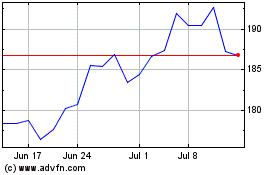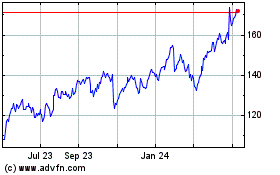U.S. Music Revenue Rose in 2017 Lifted by Spotify, Other Streaming Services
March 22 2018 - 2:57PM
Dow Jones News
By Anne Steele
The music industry's rebound continues as revenue in the U.S.
rose significantly for two consecutive years for the first time
since its 1999 peak, thanks almost entirely to the rise of
streaming services.
Domestic retail revenue jumped 17% in 2017 to $8.7 billion,
according to an annual report from the Recording Industry
Association of America, a trade group for recorded-music companies.
While that marks a return to the same level reached a decade ago,
it is still 40% lower than the industry's high-water mark, $14.6
billion, as physical and digital format sales continue their long
decline.
Music-streaming platforms -- responsible for almost all of the
industry's growth -- accounted for two-thirds of revenue last year.
That includes revenue from subscription services like those offered
by Spotify Technology SA and Apple Inc.; digital radio services
like Pandora Media Inc. and Sirius XM Holdings Inc.; and
ad-supported on-demand streaming services like Alphabet Inc.'s
YouTube. Revenue from those platforms altogether rose 43% to $5.7
billion.
Paid subscriptions, up 63%, were the largest contributor to
growth during the year, bringing in more than $4 billion to make up
47% of the market. It is by far the biggest format of recorded
music in the U.S. Revenue from ad-supported on-demand streaming
services, meanwhile, rose 35% to $659 million in 2017.
The tally of subscriptions to full on-demand services ticked up
56% to around 35.3 million for the year, compared with 22.7 million
in 2016, helped by the introduction of new services like Pandora
Premium, iHeartRadio All Access and the first full year of
Amazon.com Inc.'s Amazon Unlimited.
In 2017, a 6% dip in CD shipments weighed on physical formats,
which fell 4% to $1.5 billion. But that is a lower rate of decline
than in recent years, as vinyl's resurgence continues -- up 10% to
$395 million. Revenues from physical products accounted for just
17% of the overall market.
Revenue from digital downloads -- previously a bright spot and
the biggest contributor to revenue as recently as 2015 -- dropped
25% to $1.3 billion.
Still, the recorded music business is contending with what it
calls the "value gap" in the amount of revenue it takes in from
different forms of streaming. YouTube, in particular, has long been
a bugbear for the music industry because it pays substantially less
per song than Spotify or other pure-music services. The report
released Thursday didn't single out the video-streaming giant by
name, something the group has done in the past.
"The playing field remains unfairly tilted at the expense of
creators and digital music services, resulting in a 'value gap,'
the gulf between the amount of music being consumed and the
compensation that platforms return to music creators for exploiting
the music," says RIAA Chief Executive Cary Sherman in a blog post.
"The economic consequences are real."
Mr. Sherman complained that terrestrial radio doesn't pay
artists to air their music, and contended that satellite-radio
broadcaster SiriusXM pays a "below-market rate."
The RIAA has thrown its support behind proposed legislation in
Congress that would ensure all music platforms pay royalties on a
market-based standard, among other reforms.
"Even as the shift to streaming powers the industry's recovery,
the digital migration also exposes the growing gap in our core
rights -- because, under current laws, not all platforms pay
artists and labels fair rates reflecting market value for the use
of their music," says Mr. Sherman.
Write to Anne Steele at Anne.Steele@wsj.com
(END) Dow Jones Newswires
March 22, 2018 14:42 ET (18:42 GMT)
Copyright (c) 2018 Dow Jones & Company, Inc.
Alphabet (NASDAQ:GOOG)
Historical Stock Chart
From Mar 2024 to Apr 2024

Alphabet (NASDAQ:GOOG)
Historical Stock Chart
From Apr 2023 to Apr 2024
